engine JEEP PATRIOT 2012 1.G Owner's Manual
[x] Cancel search | Manufacturer: JEEP, Model Year: 2012, Model line: PATRIOT, Model: JEEP PATRIOT 2012 1.GPages: 108, PDF Size: 4.19 MB
Page 70 of 108
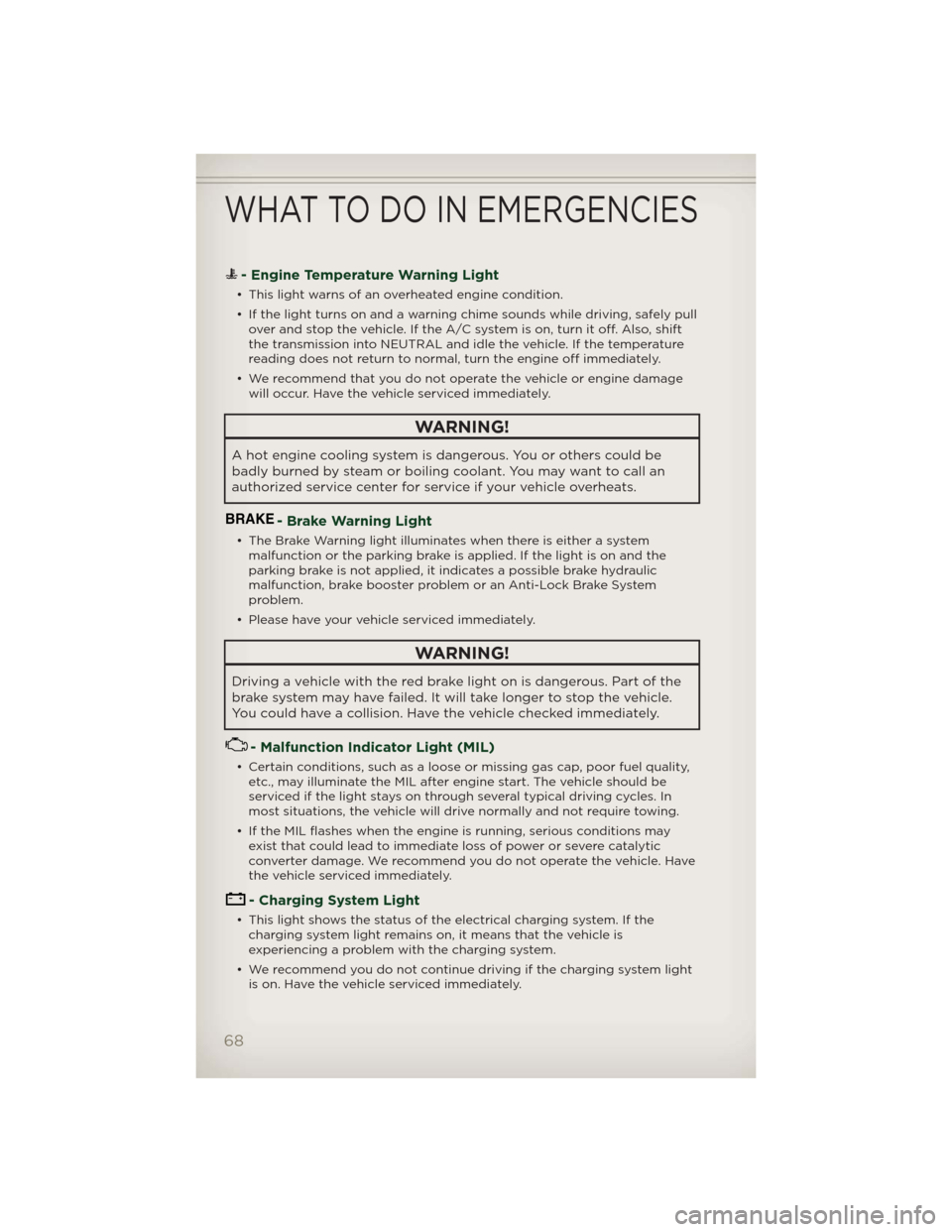
- Engine Temperature Warning Light
• This light warns of an overheated engine condition.
• If the light turns on and a warning chime sounds while driving, safely pull
over and stop the vehicle. If the A/C system is on, turn it off. Also, shift
the transmission into NEUTRAL and idle the vehicle. If the temperature
reading does not return to normal, turn the engine off immediately.
• We recommend that you do not operate the vehicle or engine damage
will occur. Have the vehicle serviced immediately.
WARNING!
A hot engine cooling system is dangerous. You or others could be
badly burned by steam or boiling coolant. You may want to call an
authorized service center for service if your vehicle overheats.
BRAKE- Brake Warning Light
• The Brake Warning light illuminates when there is either a system
malfunction or the parking brake is applied. If the light is on and the
parking brake is not applied, it indicates a possible brake hydraulic
malfunction, brake booster problem or an Anti-Lock Brake System
problem.
• Please have your vehicle serviced immediately.
WARNING!
Driving a vehicle with the red brake light on is dangerous. Part of the
brake system may have failed. It will take longer to stop the vehicle.
You could have a collision. Have the vehicle checked immediately.
- Malfunction Indicator Light (MIL)
• Certain conditions, such as a loose or missing gas cap, poor fuel quality,
etc., may illuminate the MIL after engine start. The vehicle should be
serviced if the light stays on through several typical driving cycles. In
most situations, the vehicle will drive normally and not require towing.
• If the MIL flashes when the engine is running, serious conditions may
exist that could lead to immediate loss of power or severe catalytic
converter damage. We recommend you do not operate the vehicle. Have
the vehicle serviced immediately.
- Charging System Light
• This light shows the status of the electrical charging system. If the
charging system light remains on, it means that the vehicle is
experiencing a problem with the charging system.
• We recommend you do not continue driving if the charging system light
is on. Have the vehicle serviced immediately.
WHAT TO DO IN EMERGENCIES
68
Page 71 of 108
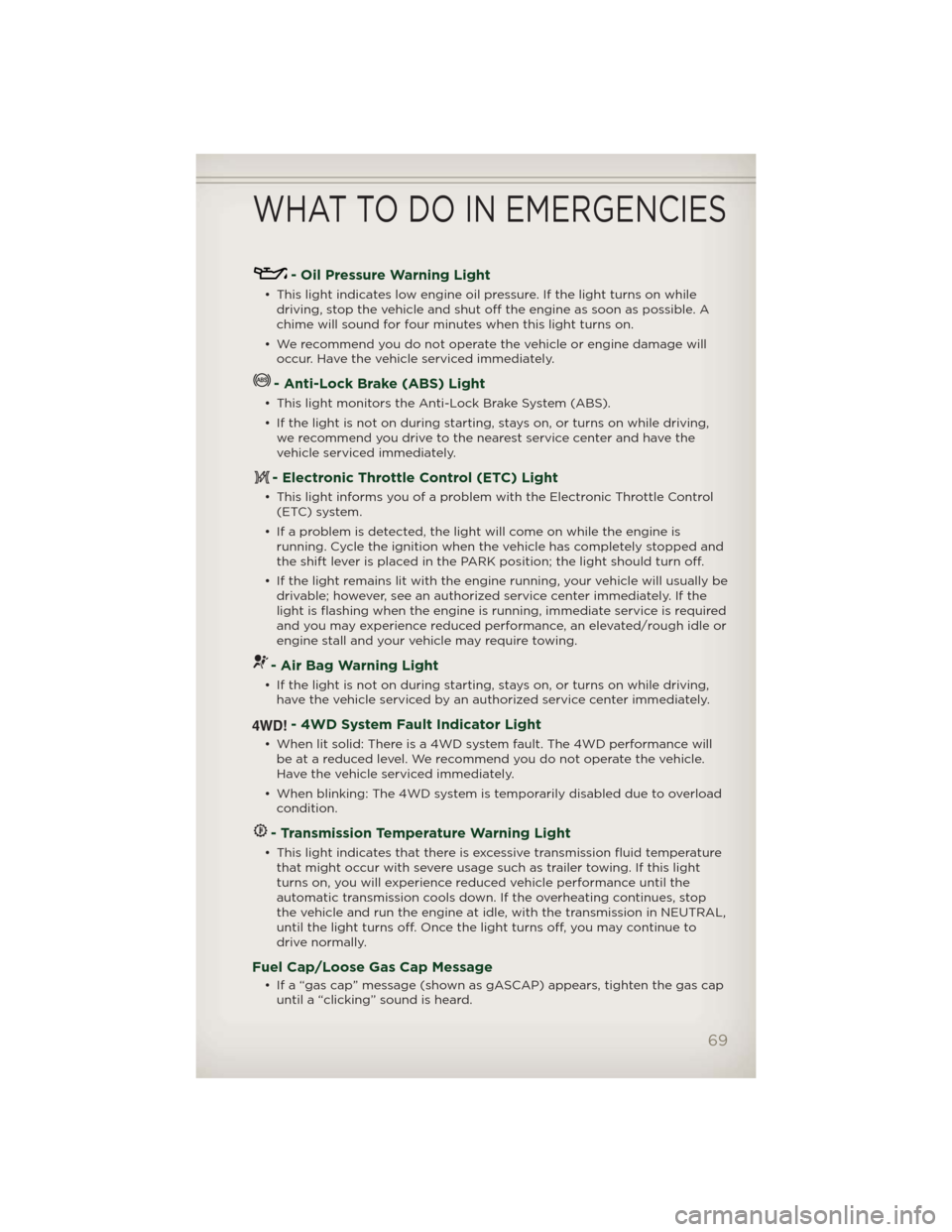
- Oil Pressure Warning Light
• This light indicates low engine oil pressure. If the light turns on while
driving, stop the vehicle and shut off the engine as soon as possible. A
chime will sound for four minutes when this light turns on.
• We recommend you do not operate the vehicle or engine damage will
occur. Have the vehicle serviced immediately.
- Anti-Lock Brake (ABS) Light
• This light monitors the Anti-Lock Brake System (ABS).
• If the light is not on during starting, stays on, or turns on while driving,
we recommend you drive to the nearest service center and have the
vehicle serviced immediately.
- Electronic Throttle Control (ETC) Light
• This light informs you of a problem with the Electronic Throttle Control
(ETC) system.
• If a problem is detected, the light will come on while the engine is
running. Cycle the ignition when the vehicle has completely stopped and
the shift lever is placed in the PARK position; the light should turn off.
• If the light remains lit with the engine running, your vehicle will usually be
drivable; however, see an authorized service center immediately. If the
light is flashing when the engine is running, immediate service is required
and you may experience reduced performance, an elevated/rough idle or
engine stall and your vehicle may require towing.
- Air Bag Warning Light
• If the light is not on during starting, stays on, or turns on while driving,
have the vehicle serviced by an authorized service center immediately.
4WD!- 4WD System Fault Indicator Light
• When lit solid: There is a 4WD system fault. The 4WD performance will
be at a reduced level. We recommend you do not operate the vehicle.
Have the vehicle serviced immediately.
• When blinking: The 4WD system is temporarily disabled due to overload
condition.
- Transmission Temperature Warning Light
• This light indicates that there is excessive transmission fluid temperature
that might occur with severe usage such as trailer towing. If this light
turns on, you will experience reduced vehicle performance until the
automatic transmission cools down. If the overheating continues, stop
the vehicle and run the engine at idle, with the transmission in NEUTRAL,
until the light turns off. Once the light turns off, you may continue to
drive normally.
Fuel Cap/Loose Gas Cap Message
• If a “gas cap” message (shown as gASCAP) appears, tighten the gas cap
until a “clicking” sound is heard.
WHAT TO DO IN EMERGENCIES
69
Page 72 of 108
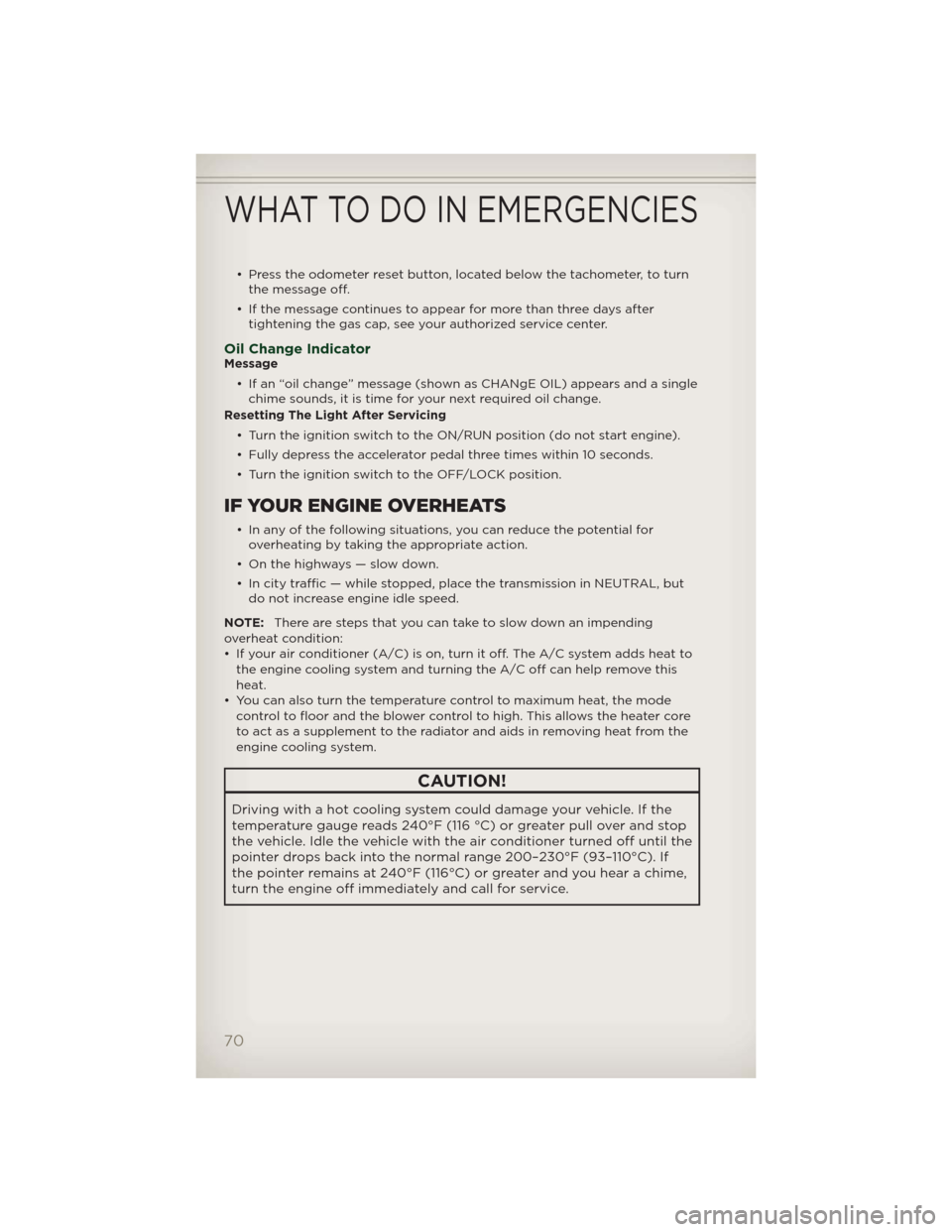
• Press the odometer reset button, located below the tachometer, to turn
the message off.
• If the message continues to appear for more than three days after
tightening the gas cap, see your authorized service center.
Oil Change IndicatorMessage
• If an “oil change” message (shown as CHANgE OIL) appears and a single
chime sounds, it is time for your next required oil change.
Resetting The Light After Servicing
• Turn the ignition switch to the ON/RUN position (do not start engine).
• Fully depress the accelerator pedal three times within 10 seconds.
• Turn the ignition switch to the OFF/LOCK position.
IF YOUR ENGINE OVERHEATS
• In any of the following situations, you can reduce the potential for
overheating by taking the appropriate action.
• On the highways — slow down.
• In city traffic — while stopped, place the transmission in NEUTRAL, but
do not increase engine idle speed.
NOTE:There are steps that you can take to slow down an impending
overheat condition:
• If your air conditioner (A/C) is on, turn it off. The A/C system adds heat to
the engine cooling system and turning the A/C off can help remove this
heat.
• You can also turn the temperature control to maximum heat, the mode
control to floor and the blower control to high. This allows the heater core
to act as a supplement to the radiator and aids in removing heat from the
engine cooling system.
CAUTION!
Driving with a hot cooling system could damage your vehicle. If the
temperature gauge reads 240°F (116 °C) or greater pull over and stop
the vehicle. Idle the vehicle with the air conditioner turned off until the
pointer drops back into the normal range 200–230°F (93–110°C). If
the pointer remains at 240°F (116°C) or greater and you hear a chime,
turn the engine off immediately and call for service.
WHAT TO DO IN EMERGENCIES
70
Page 73 of 108
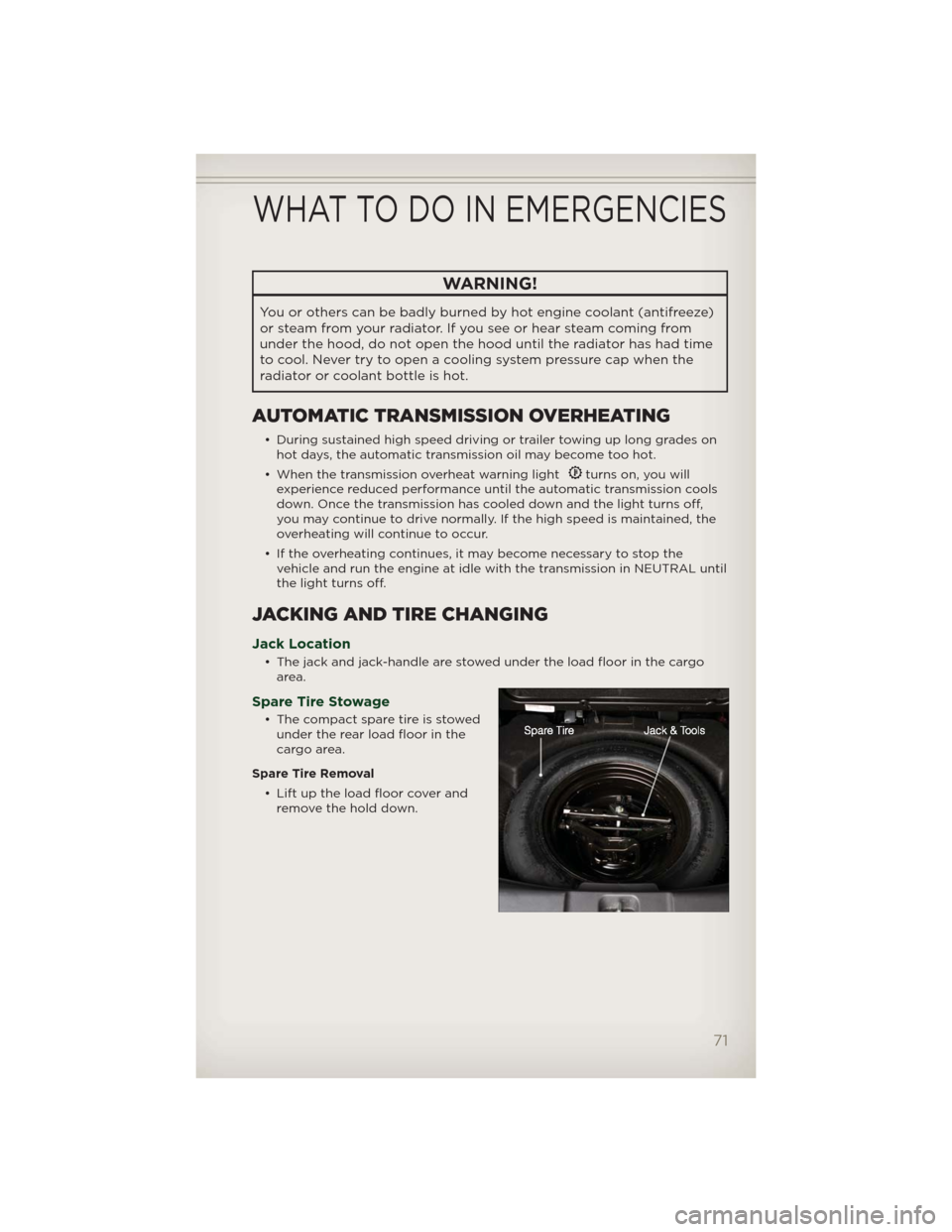
WARNING!
You or others can be badly burned by hot engine coolant (antifreeze)
or steam from your radiator. If you see or hear steam coming from
under the hood, do not open the hood until the radiator has had time
to cool. Never try to open a cooling system pressure cap when the
radiator or coolant bottle is hot.
AUTOMATIC TRANSMISSION OVERHEATING
• During sustained high speed driving or trailer towing up long grades on
hot days, the automatic transmission oil may become too hot.
• When the transmission overheat warning light
turns on, you will
experience reduced performance until the automatic transmission cools
down. Once the transmission has cooled down and the light turns off,
you may continue to drive normally. If the high speed is maintained, the
overheating will continue to occur.
• If the overheating continues, it may become necessary to stop the
vehicle and run the engine at idle with the transmission in NEUTRAL until
the light turns off.
JACKING AND TIRE CHANGING
Jack Location
• The jack and jack-handle are stowed under the load floor in the cargo
area.
Spare Tire Stowage
• The compact spare tire is stowed
under the rear load floor in the
cargo area.
Spare Tire Removal
• Lift up the load floor cover and
remove the hold down.
WHAT TO DO IN EMERGENCIES
71
Page 77 of 108
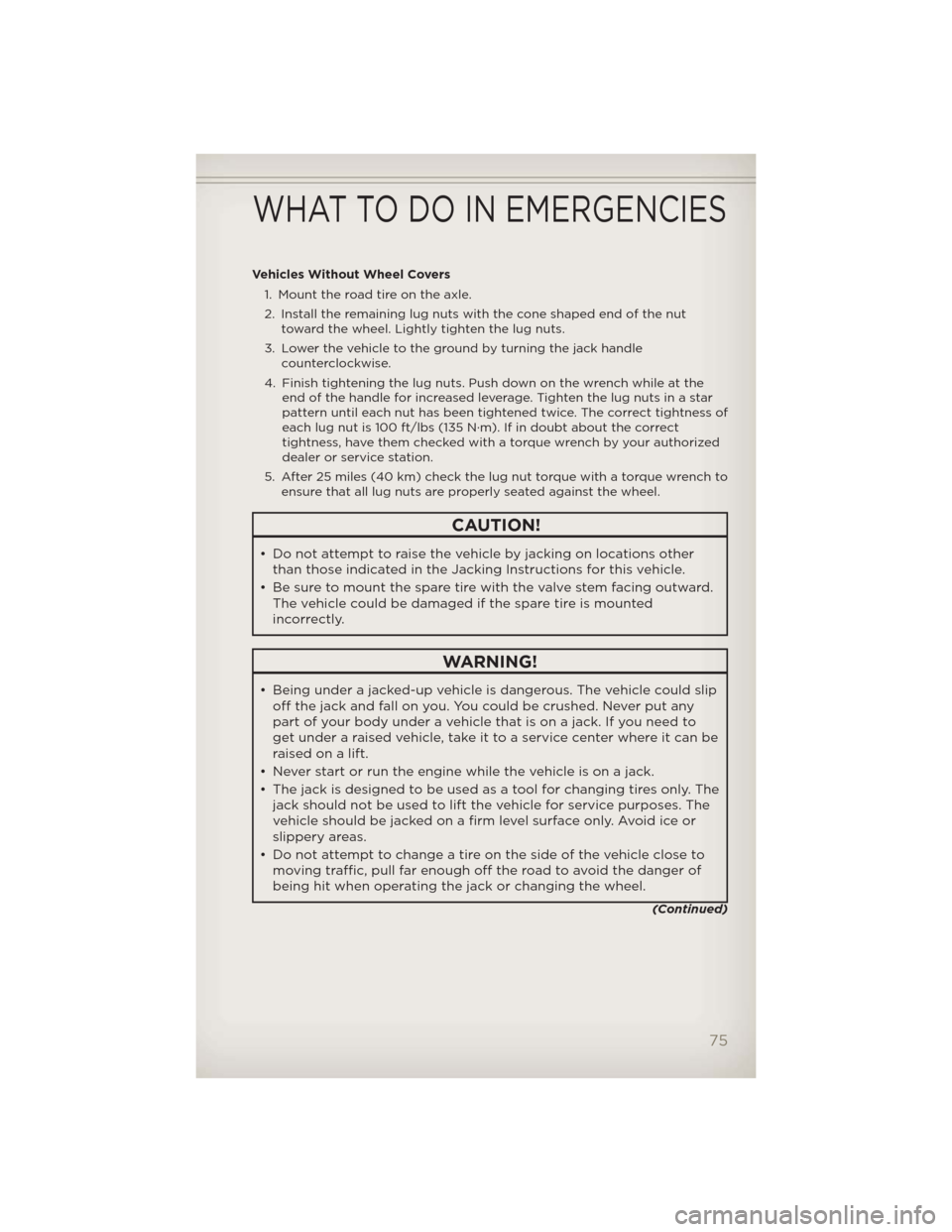
Vehicles Without Wheel Covers
1. Mount the road tire on the axle.
2. Install the remaining lug nuts with the cone shaped end of the nut
toward the wheel. Lightly tighten the lug nuts.
3. Lower the vehicle to the ground by turning the jack handle
counterclockwise.
4. Finish tightening the lug nuts. Push down on the wrench while at the
end of the handle for increased leverage. Tighten the lug nuts in a star
pattern until each nut has been tightened twice. The correct tightness of
each lug nut is 100 ft/lbs (135 N·m). If in doubt about the correct
tightness, have them checked with a torque wrench by your authorized
dealer or service station.
5. After 25 miles (40 km) check the lug nut torque with a torque wrench to
ensure that all lug nuts are properly seated against the wheel.
CAUTION!
• Do not attempt to raise the vehicle by jacking on locations other
than those indicated in the Jacking Instructions for this vehicle.
• Be sure to mount the spare tire with the valve stem facing outward.
The vehicle could be damaged if the spare tire is mounted
incorrectly.
WARNING!
• Being under a jacked-up vehicle is dangerous. The vehicle could slip
off the jack and fall on you. You could be crushed. Never put any
part of your body under a vehicle that is on a jack. If you need to
get under a raised vehicle, take it to a service center where it can be
raised on a lift.
• Never start or run the engine while the vehicle is on a jack.
• The jack is designed to be used as a tool for changing tires only. The
jack should not be used to lift the vehicle for service purposes. The
vehicle should be jacked on a firm level surface only. Avoid ice or
slippery areas.
• Do not attempt to change a tire on the side of the vehicle close to
moving traffic, pull far enough off the road to avoid the danger of
being hit when operating the jack or changing the wheel.
(Continued)
WHAT TO DO IN EMERGENCIES
75
Page 78 of 108
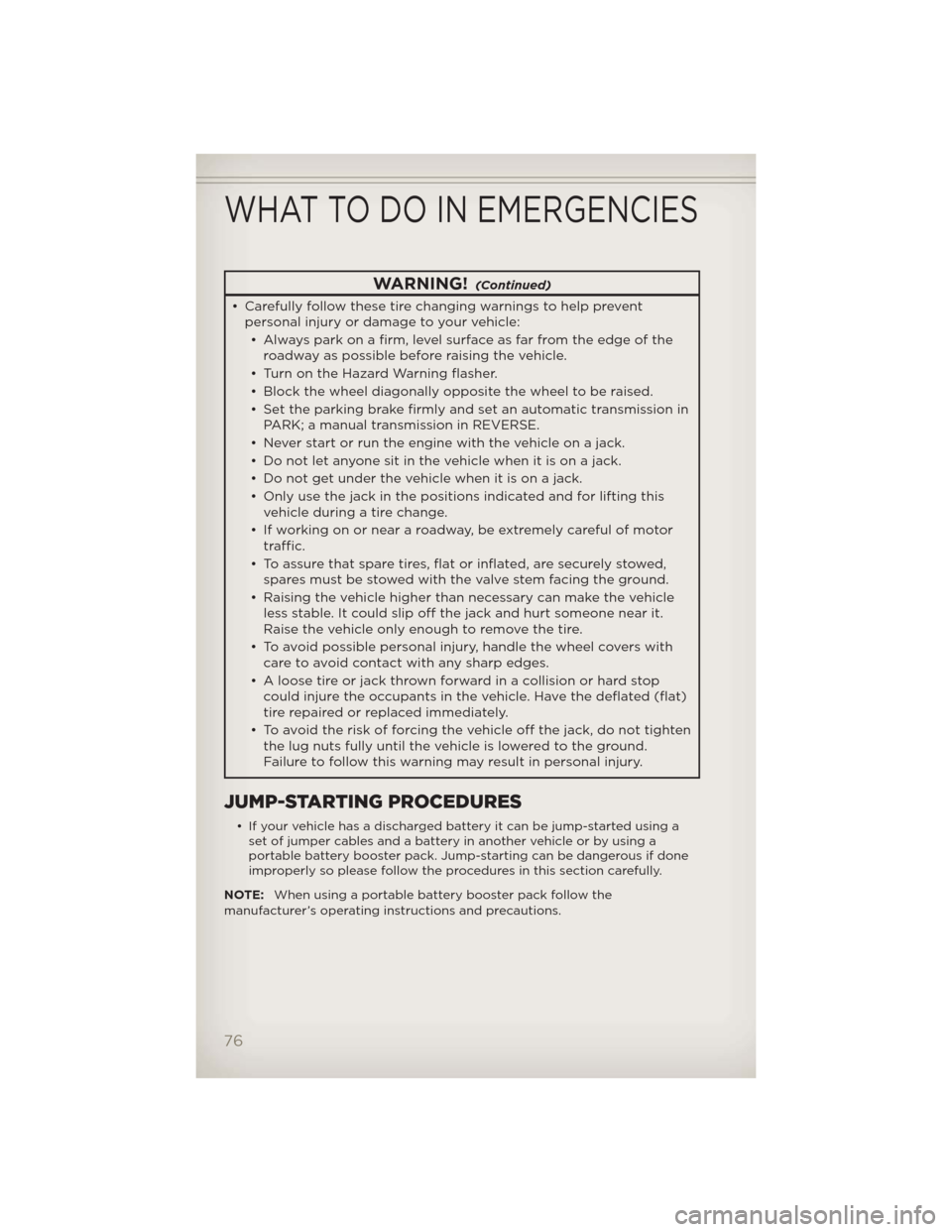
WARNING!(Continued)
• Carefully follow these tire changing warnings to help prevent
personal injury or damage to your vehicle:
• Alwayspark on a firm, level surface as far from the edge of the
roadway as possible before raising the vehicle.
• Turn on the Hazard Warning flasher.
• Block the wheel diagonally opposite the wheel to be raised.
• Set the parking brake firmly and set an automatic transmission in
PARK; a manual transmission in REVERSE.
• Never start or run the engine with the vehicle on a jack.
• Do not let anyone sit in the vehicle when it is on a jack.
• Do not get under the vehicle when it is on a jack.
• Only use the jack in the positions indicated and for lifting this
vehicle during a tire change.
• If working on or near a roadway, be extremely careful of motor
traffic.
• To assure that spare tires, flat or inflated, are securely stowed,
spares must be stowed with the valve stem facing the ground.
• Raising the vehicle higher than necessary can make the vehicle
less stable. It could slip off the jack and hurt someone near it.
Raise the vehicle only enough to remove the tire.
• To avoid possible personal injury, handle the wheel covers with
care to avoid contact with any sharp edges.
• A loose tire or jack thrown forward in a collision or hard stop
could injure the occupants in the vehicle. Have the deflated (flat)
tire repaired or replaced immediately.
• To avoid the risk of forcing the vehicle off the jack, do not tighten
the lug nuts fully until the vehicle is lowered to the ground.
Failure to follow this warning may result in personal injury.
JUMP-STARTING PROCEDURES
• If your vehicle has a discharged battery it can be jump-started using a
set of jumper cables and a battery in another vehicle or by using a
portable battery booster pack. Jump-starting can be dangerous if done
improperly so please follow the procedures in this section carefully.
NOTE:When using a portable battery booster pack follow the
manufacturer’s operating instructions and precautions.
WHAT TO DO IN EMERGENCIES
76
Page 79 of 108
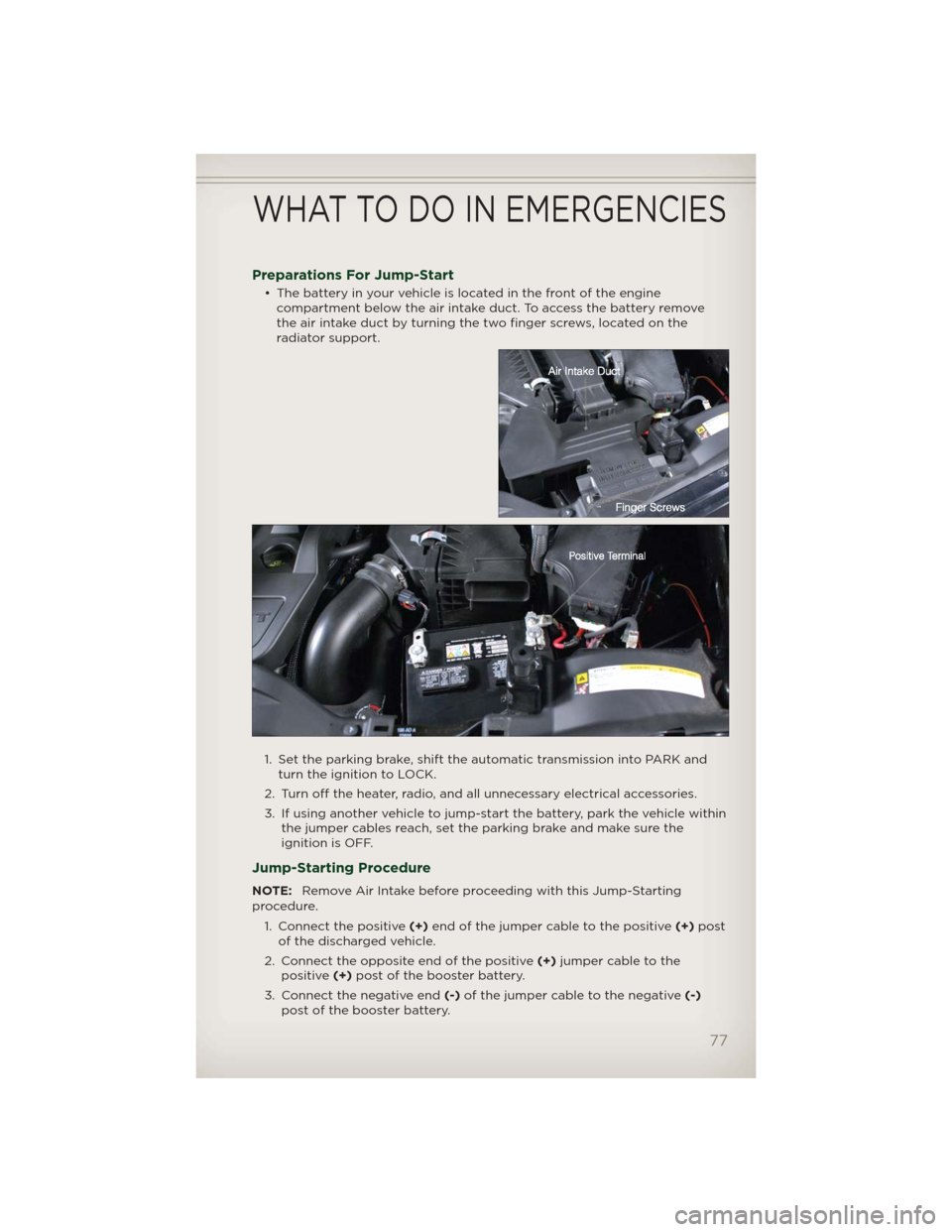
Preparations For Jump-Start
• The battery in your vehicle is located in the front of the engine
compartment below the air intake duct. To access the battery remove
the air intake duct by turning the two finger screws, located on the
radiator support.
1. Set the parking brake, shift the automatic transmission into PARK and
turn the ignition to LOCK.
2. Turn off the heater, radio, and all unnecessary electrical accessories.
3. If using another vehicle to jump-start the battery, park the vehicle within
the jumper cables reach, set the parking brake and make sure the
ignition is OFF.
Jump-Starting Procedure
NOTE:Remove Air Intake before proceeding with this Jump-Starting
procedure.
1. Connect the positive(+)end of the jumper cable to the positive(+)post
of the discharged vehicle.
2. Connect the opposite end of the positive(+)jumper cable to the
positive(+)post of the booster battery.
3. Connect the negative end(-)of the jumper cable to the negative(-)
post of the booster battery.
WHAT TO DO IN EMERGENCIES
77
Page 80 of 108
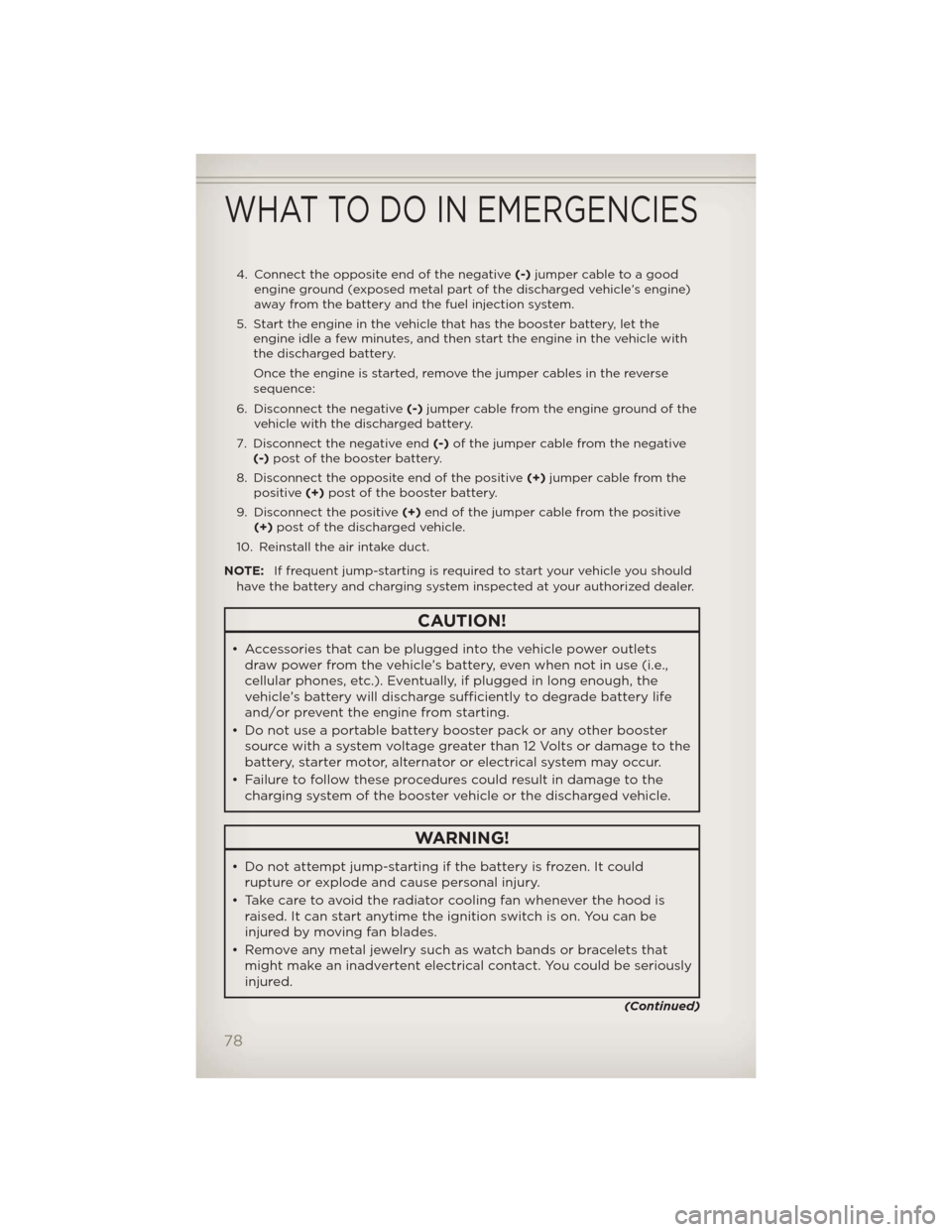
4. Connect the opposite end of the negative(-)jumper cable to a good
engine ground (exposed metal part of the discharged vehicle’s engine)
away from the battery and the fuel injection system.
5. Start the engine in the vehicle that has the booster battery, let the
engine idle a few minutes, and then start the engine in the vehicle with
the discharged battery.
Once the engine is started, remove the jumper cables in the reverse
sequence:
6. Disconnect the negative(-)jumper cable from the engine ground of the
vehicle with the discharged battery.
7. Disconnect the negative end(-)of the jumper cable from the negative
(-)post of the booster battery.
8. Disconnect the opposite end of the positive(+)jumper cable from the
positive(+)post of the booster battery.
9. Disconnect the positive(+)end of the jumper cable from the positive
(+)post of the discharged vehicle.
10. Reinstall the air intake duct.
NOTE:If frequent jump-starting is required to start your vehicle you should
have the battery and charging system inspected at your authorized dealer.
CAUTION!
• Accessories that can be plugged into the vehicle power outlets
draw power from the vehicle’s battery, even when not in use (i.e.,
cellular phones, etc.). Eventually, if plugged in long enough, the
vehicle’s battery will discharge sufficiently to degrade battery life
and/or prevent the engine from starting.
• Do not use a portable battery booster pack or any other booster
source with a system voltage greater than 12 Volts or damage to the
battery, starter motor, alternator or electrical system may occur.
• Failure to follow these procedures could result in damage to the
charging system of the booster vehicle or the discharged vehicle.
WARNING!
• Do not attempt jump-starting if the battery is frozen. It could
rupture or explode and cause personal injury.
• Take care to avoid the radiator cooling fan whenever the hood is
raised. It can start anytime the ignition switch is on. You can be
injured by moving fan blades.
• Remove any metal jewelry such as watch bands or bracelets that
might make an inadvertent electrical contact. You could be seriously
injured.
(Continued)
WHAT TO DO IN EMERGENCIES
78
Page 81 of 108
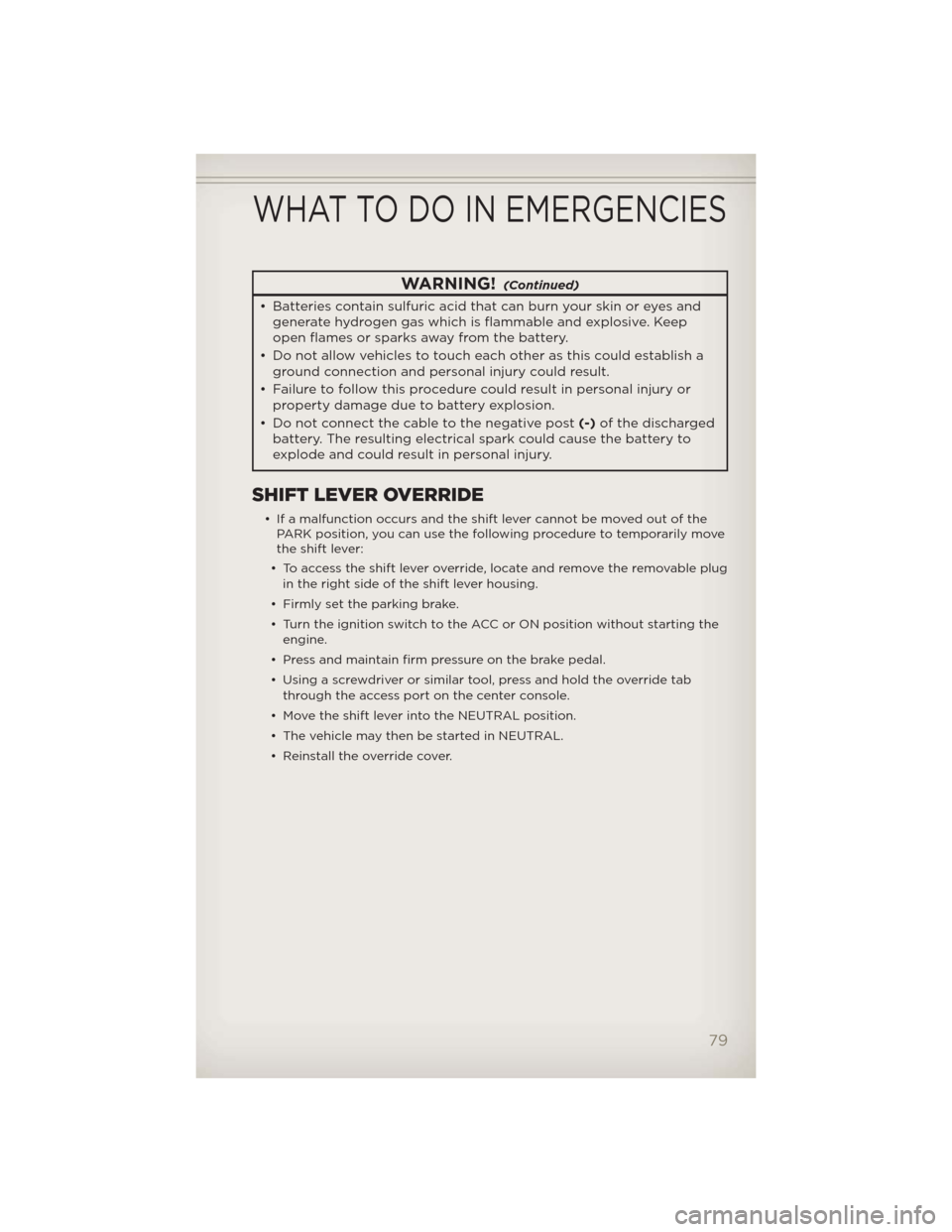
WARNING!(Continued)
• Batteries contain sulfuric acid that can burn your skin or eyes and
generate hydrogen gas which is flammable and explosive. Keep
open flames or sparksaway from the battery.
• Do not allow vehicles to touch each other as this could establish a
ground connection and personal injury could result.
• Failure to follow this procedure could result in personal injury or
property damage due to battery explosion.
• Do not connect the cable to the negative post(-)of the discharged
battery. The resulting electrical spark could cause the battery to
explode and could result in personal injury.
SHIFT LEVER OVERRIDE
• If a malfunction occurs and the shift lever cannot be moved out of the
PARK position, you can use the following procedure to temporarily move
the shift lever:
• To access the shift lever override, locate and remove the removable plug
in the right side of the shift lever housing.
• Firmly set the parking brake.
• Turn the ignition switch to the ACC or ON position without starting the
engine.
• Press and maintain firm pressure on the brake pedal.
• Using a screwdriver or similar tool, press and hold the override tab
through the access port on the center console.
• Move the shift lever into the NEUTRAL position.
• The vehicle may then be started in NEUTRAL.
• Reinstall the override cover.
WHAT TO DO IN EMERGENCIES
79
Page 83 of 108
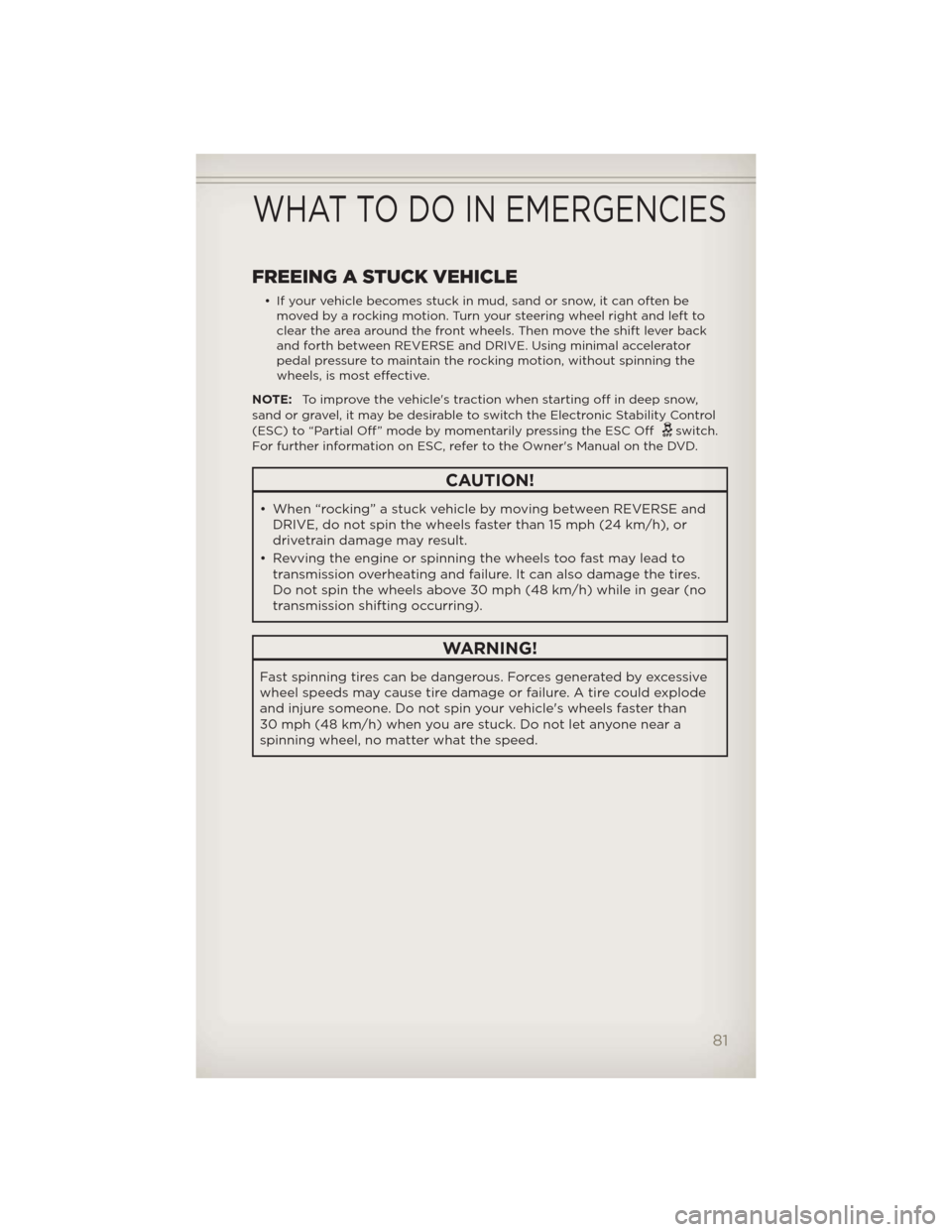
FREEING A STUCK VEHICLE
• If your vehicle becomes stuck in mud, sand or snow, it can often be
moved by a rocking motion. Turn your steering wheel right and left to
clear the area around the front wheels. Then move the shift lever back
and forth between REVERSE and DRIVE. Using minimal accelerator
pedal pressure to maintain the rocking motion, without spinning the
wheels, is most effective.
NOTE:To improve the vehicle's traction when starting off in deep snow,
sand or gravel, it may be desirable to switch the Electronic Stability Control
(ESC) to “Partial Off” mode by momentarily pressing the ESC Off
switch.
For further information on ESC, refer to the Owner's Manual on the DVD.
CAUTION!
• When “rocking” a stuck vehicle by moving between REVERSE and
DRIVE, do not spin the wheels faster than 15 mph (24 km/h), or
drivetrain damage may result.
• Revving the engine or spinning the wheels too fast may lead to
transmission overheating and failure. It can also damage the tires.
Do not spin the wheels above 30 mph (48 km/h) while in gear (no
transmission shifting occurring).
WARNING!
Fast spinning tires can be dangerous. Forces generated by excessive
wheel speeds may cause tire damage or failure. A tire could explode
and injure someone. Do not spin your vehicle's wheels faster than
30 mph (48 km/h) when you are stuck. Do not let anyone near a
spinning wheel, no matter what the speed.
WHAT TO DO IN EMERGENCIES
81